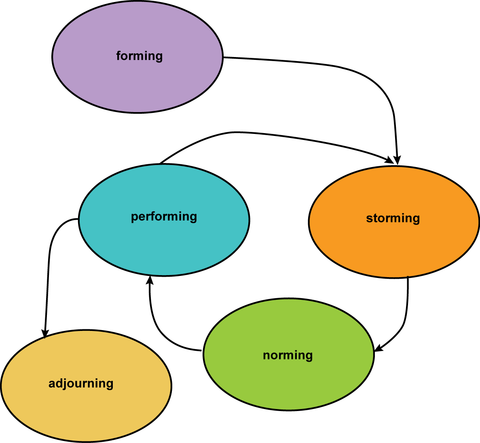We’ve all been part of a group project before, whether for school or work (or likely both). As a result, we’re all aware of the challenges one can present. We tend to have strong feelings about who we want to work with and what we want the process to look like.
To make group work a better experience for all participants, it’s helpful to understand group dynamics.
Group dynamics is the process by which people work together toward a common goal. Working in groups has many benefits, including building a sense of belonging, having diverse perspectives and skills, sharing burdens, and creating support networks. Understanding how groups work, however, is key. Bruce Tuckman developed a model that considers the different stages of group development. Though not perfect or all-inclusive, his particular model is well-known and commonly used.
According to Tuckman, the five stages of group development include:
Forming
The first thing groups do is form. During this stage, group members may feel excited or uncertain, and they may concede their opinions to avoid conflict (especially if they hold marginalized identities). While the group forms, make sure you outline roles and expectations for the group and its goals.
Storming
After groups form and people become comfortable, they begin to storm. This stage may include conflict as people start to share their personal goals, their different ways of understanding the group’s goals, and their preferred working and communication styles.
This stage can also highlight cultural differences and power dynamics related to social identities. It is important to remind group members that conflict is a normal part of group development and to try not to take things personally. Groups change frequently; if a group advances from this stage, but then a new member joins, the group may need to storm again.
Norming
Once people’s true feelings emerge and conflict arises, compromise is eventually reached during the norming stage. During this stage, groups solidify their expectations, roles, strengths, and weaknesses.
The group also realizes its diversity as a strength and members understand one another more deeply, allowing them to effectively communicate and work together as a unit.
Performing
This is usually the stage groups want to be in. When groups start to work on and accomplish the goal they set during forming, they are performing. Many groups never reach this stage because they try to skip the earlier stages; however, when they do, “their capacity, range, and depth of personal relations expand to true interdependence.” In this stage, groups find their flow and move into action.
Adjourning
Even ongoing teams have projects that eventually end. A group dissolving is part of the adjournment stage. One way to promote positive closure is by highlighting successes and framing areas for improvement as learning opportunities. Groups can also adjourn positively through a reflection session, a communal meal, or a graduation ceremony.
Understanding the five stages of group development can help you better understand group dynamics and how to solve group issues. Groups are unique and ever-changing; McRae and Dias emphasize that “Racial, cultural, and gender dynamics when not recognized and worked with can create havoc in an organization.”
What stage is your group in? What can you do to help move your group to the next stage?
- McRae, M. B., & Short, E. L. (2010). Racial and cultural dynamics in group and organizational life: crossing boundaries. Sage.
- McRae, M. B., & Dias, S. I, (2014). In the Boardroom/Out of the Loop: Group and Organizational Dynamics. In Miville, M. L., & Ferguson, A. D. (Eds.). (2014). Handbook of race-ethnicity and gender in psychology. (p. 295-309). Springer.
- Tuckman, B. W. (1965). Developmental sequence in small groups. Psychological Bulletin, 63(6), 384–399.
- Tuckman, B. W., & Jensen, M. A. C. (1977). Stages of small-group development revisited. Group & Organization Studies, 2(4), 419–427.
- West Chester University. (2022, September 28). Tuckman’s stages of group development. Collaborative Online Research and Learning.



